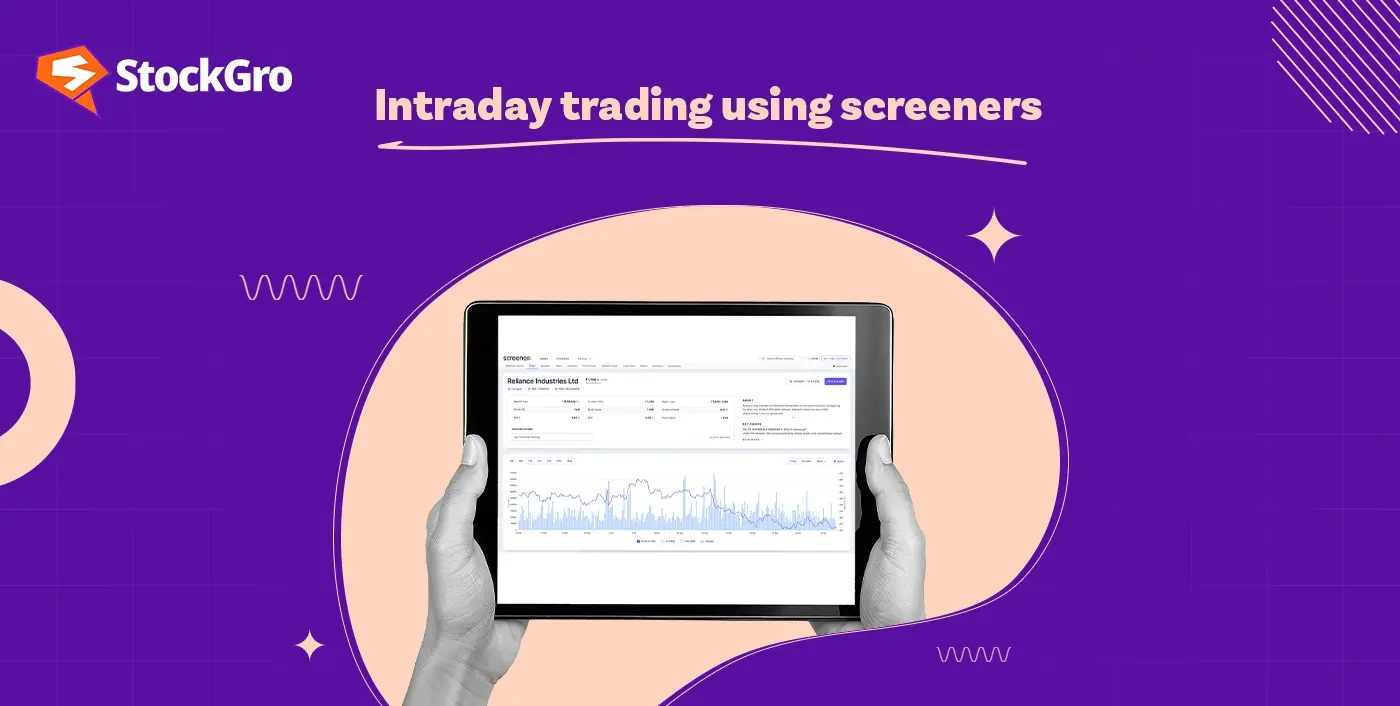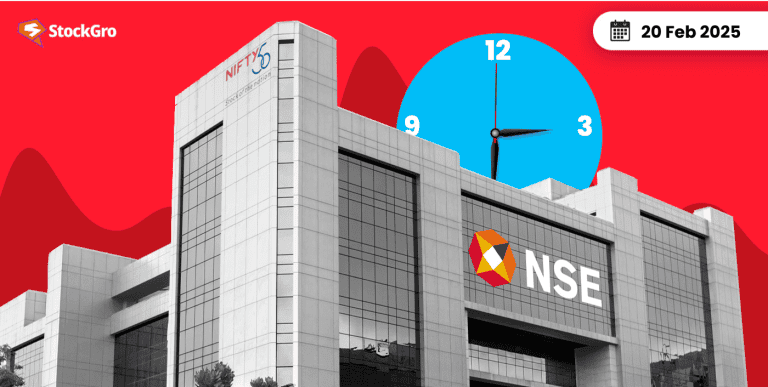
The stock market has become very big and fast-paced. Every second, a number of changes are happening in the stock market, and it is impossible for a trader to manually keep track of all these changes in a single trading session. That is where software like stock screener comes in.
Let us delve into the world of stock screeners and understand how you can build an intraday trading strategy using stock screeners.
What are stock screeners?
Stock screeners are tools that can filter through stocks according to a given set of pre-defined rules. These software programs can save traders time and effort by eliminating the need to search through listed stocks manually to find suitable options for intraday trading.
Traders can feed their requirements into the screening software, and the software goes through real-time price and fundamental data of all the listed companies to pick the stocks as per the trader’s criteria. This saves a lot of time.
Here is a step-by-step guide to intraday trading using stock screeners.
An interesting read: Day Trading vs Swing Trading
Step-by-step guide: Trading strategy using screeners
Let us look at the step by step guide to intraday trading using stock screeners.
Step 1: Making a clear trading plan
The first step is defining your trading plan. A trading plan should encompass clear rules for the strategy you wish to use, which can be a breakout strategy, trend-following strategy, etc. The rules for entry, exit, and position sizing should also be well-defined.
Even the most efficient stock screeners won’t be able to benefit you if you don’t have a clear trading plan.
Step 2: Select the right screener.
Once you have clearly defined the trading rules, the next step is choosing the right stock screener. Depending on the nature of your intraday trading strategy, you have to choose the right screener. Some screeners might have better breakout signals, whereas some might have better technical indicator signals.
The screener you choose must have real-time data, customizable filters, and a stock alert feature. A screener with all these features can help traders increase efficiency in intraday trading.
Also read: Top 5 intraday screeners every trader should use in 2025
Step 3: Applying broad filters
In the stock markets, out of all the listed stocks, not all of them can be used for intraday trading. Many of these stocks can have liquidity issues or these companies might be too unstable. It is important to filter out these companies as they can present unnecessary risk. Stock screeners can be used to filter out such companies.
Traders can use filters like:
- Market capitalization: Stocks with very low market capitalization can be highly unstable for intraday trading
- Liquidity: Look for stocks that have high liquidity so that buy and sell orders can be easily fulfilled.
- Fundamentals: Avoid stocks that are extremely overvalued.
While applying broad filters, you do not need a real-time stock screener.
Step 4: Refining the screener with intraday trading rules
After filtering out the stocks with low liquidity and stocks with high risk, the trader is left with a pool of stocks that are highly liquid and stable. The next step includes incorporating advanced screeners to filter stocks as per the trader’s strategy. Here are some of the most commonly used trading filters:
Volatility filters
- Stocks with medium to high volatility can be appropriate for intraday trading, as low volatility can lead prices to neither reach profit targets nor stop loss.
- Volatility indicators like Average True Range (ATR), standard deviation, etc, can be used to filter out stocks with low volatility.
Breakout & momentum filters
- Many intraday traders employ breakout strategies and momentum indicators for their trading strategies.
- Traders can use breakout filters, like stocks at 52-week high/low, 1-month high/low, previous day high/low, above average volume, etc, to find real-time stocks with price breakouts.
- Real-time momentum indicators like moving average convergence/ divergence (MACD), RSI, etc, can be used to confirm the breakouts.
- Stock screeners can give you a real-time list of stocks that are fulfilling the above-mentioned breakout and momentum criteria. This can help you save a lot of time.
Price action filters
- Some stock screeners also provide price action filters. For example, Stockgro has a screener for real-time candlestick pattern detection.
- Traders can use other screeners to find intraday price action trading opportunities by using trend indicators like moving averages.
Stock screening software allows traders to set alerts that notify them when a stock meets their specified criteria. These are some methods for utilizing stock screeners, but it is important to note that there are numerous other stock screening methods available beyond those mentioned here.
An interesting read: Stock Market Indicators for Savvy Traders
Step 5: Executing the trades
Stock screener provides you with stocks that fulfill your trading criteria in real time. However, it does not execute trades on its own. Trade execution has to be done either manually or using other software. Relying on a screener without a good trade execution plan can lead to missed opportunities or poor trade management.
Step 6: Risk management
Remember that using stock screeners does not eliminate risk. Traders must clearly define proper risk management and position sizing rules while defining their intraday trading strategy. Stock screeners can present a huge number of intraday stocks that fulfill your trading criteria. This should not lead to overtrading.
For example, if your screener shows 20 stocks meeting your criteria, trading all of them can lead to overtrading and excessive risk exposure. Instead, traders can focus on high-probability setups with proper use of stop loss and it is a common approach for intraday traders to not risk more than 1 – 2% of their capital on a single trade.
Also read: Risk management in stock market
Step 7: Virtual testing & constant feedback
Before starting trading with real money, it is advisable to test the validity of your intraday trading strategy and screeners by using virtual money first. You can use Stockgro’s virtual trading feature for this purpose.
Traders have to keep changing the rules for their trading screeners with changes in the market dynamics. Constantly gaining feedback from your intraday trading strategy and stock screener is important, and constantly updating it is also necessary.
Bottomline
This guide to intraday trading using stock screeners can help traders find potential intraday trading setups in a structured way, but the real value of stock screeners comes from being part of a solid intraday trading strategy. Success with intraday trading requires disciplined execution, effective risk management, and ongoing learning. Traders can identify high-probability opportunities with greater confidence by systematically filtering stocks using stock screeners.
FAQs
1. Can you automate your trading process using stock screeners?
No, stock screeners only filter out stocks as per a given criteria. Trade execution has to be done by traders either manually or with the help of any other algorithmic trading software. Some brokers might provide traders the facility to automatically execute trades based on the screening results.
2. Can stock screeners predict future stock price movements?
Stock screeners do not predict future price movements. Screeners filter out stocks based on the set of rules fed into them by the traders. The accuracy of the trading results depends on the strategy being used. Market conditions and human psychology also play a major role in stock price action.
3. Do professional traders use stock screeners, or are they used just by beginners?
Yes, professional traders also use stock screeners, although the screeners used by them can be custom-built for their trading strategies. They might also use advanced screeners that can process large amounts of financial data to gain an edge. Beginners can also start learning about stock screeners with the help of free stock screening softwares.
4. Which is the most commonly used stock screener?
Stock screeners that use basic price action like 52-week price highs/lows, volume breakouts etc., are used most widely among intraday traders. Some crossover screeners, like moving average crossovers, are also used commonly for identifying trend reversal, momentum shifts, and potential breakouts in intraday trading.
5. How can long-term investors use stock screeners?
Stock screeners can be utilised by long-term investors to filter stocks based on fundamental metrics, such as P/E ratio, revenue growth, debt levels, and return on equity. Additionally, you can even use them to find undervalued companies, stocks that pay consistent dividends, or leaders in a specific sector. This helps you find good investments that match your long-term financial goals.

